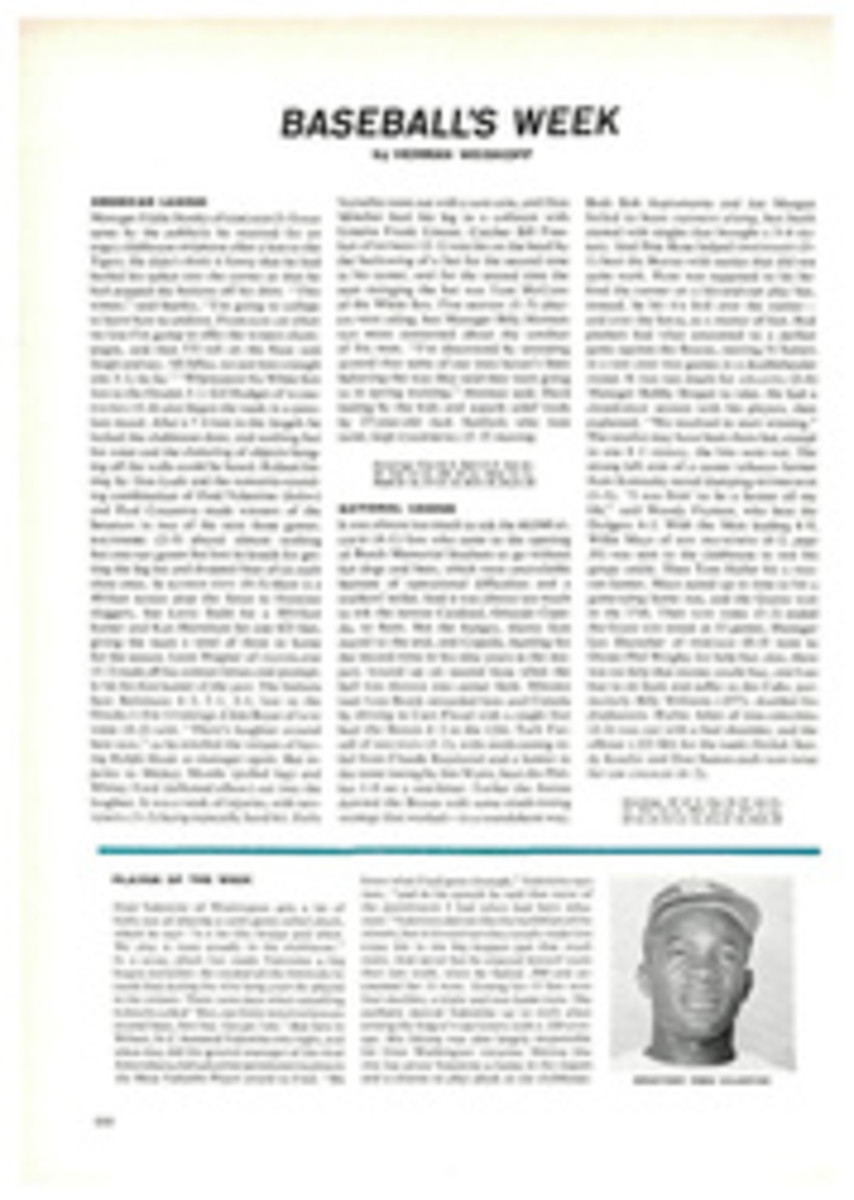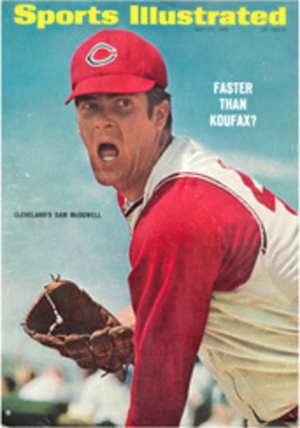
IT'S NOT BAD TO BE GOING GOOD
It was 30 minutes to game time and the tension was mounting. The San Francisco Giants hadn't lost a game in 12 days and their manager hadn't snapped at anyone in almost three hours.
Some men are irascible out of sheer talent, but Herman Franks is a sell-made grouch, almost never angry at anybody but almost always pretending, with Actors Studio credibility, that he is. Yet he is human, and what mortal could put out 100% orneriness with a 10-game winning streak and Juan Marichal ready to go? Franks munched his cud and gave Willie Mays some Keynesian insights on capital gains. The smell of success was almost too sweet until Herman saw his lineup card, taped to the back wall of the dugout, over the water cooler.
"Hey, get that thing offa there," Franks barked at an attendant. "It's been over the bat rack the last two nights." The attendant attended to it, quickly—baseball superstition, of course, like Birdie Tebbetts' not getting a haircut until his Indians had lost a game.
Whether or not the maneuver placated the gods, it called attention to the lineup. For his next trick, Franks had devised a team of nine right-handed hitters to minimize the menace of the Pittsburgh Pirates' fearsome southpaw, Bob Veale. In eight positions that had been easy, but who's on first? DAVFNPORT, 1B, Franks had block-lettered, then settled back to rehearse answers like, "What makes you think he can't?"
Nobody asked the question, because the Giants were Going Good. It is a conviction among baseball men that a team going good can get away with anything. Going good does not necessarily mean a team is hitting well or otherwise covering itself with glory. All last week the Giants had to scratch and claw to score runs, and they needed help from the Pirates and the Mets both to keep the winning streak alive. Going good is getting the help you need. It is a Met rookie hitting his first big-league home run to "win" the game in the fourth inning, then pulling his first big-league rock on the base paths to give it back in the 14th. It is the Pirates' management looking out the window at a steady rain all day, then deciding it's a bright idea to play that night—even against Juan Marichal. It is getting only three hits off Bob Gibson twice in a row and yet beating him twice in a row. Going good is winning.
So Third Baseman Jim Davenport, half an inch shorter than the 5 feet 11 they give him in the book, put all but his index finger into one of Willie Mays's gloves ("I wouldn't use a first baseman's mitt if I had one") and went to work, troubled only by the recollection that in a burst of esprit he once told Franks he could catch, too. "Bring all your gloves, boys," Franks told his troops. "We may have invented a new system."
Davenport can handle any baseball batted or thrown in his vicinity, but if somebody made a normal high throw at a normal first baseman's altitude, it could go in the box seats and splatter egg on Herman's face. Shortstop Hal Lanier did just that in the seventh inning, but Franks was still going good. At the beginning of the inning, with Marichal holding a 2-0 lead, he had replaced Davenport with Len Gabrielson. Gabe is 6 feet 4 and he caught Lanier's throw. Davenport would have been a spectator.
Davenport would have been a basket case if the Pirates' pitching rotation had been reversed and he had been playing first a night earlier. In that game Gabrielson, in rapid succession, caught the ball with his glove and Willie Stargell with his chest, and Gabe doesn't know what hit him yet. Had Davenport been in Stargell's path, Franks could have sold Jim for $136.50, assuming that diced infielders sell at the same price per pound as chopped chuck.
Davenport didn't know if he could play first or not but, making his first put-out, lifetime, as a first baseman, he pulled his foot off the bag an instant before he caught the ball. The play wasn't that close, but the importance is in the sheer artistry of a caper that some first basemen take years to learn. Davenport executed it as neatly as ever Whitey Lockman did.
The majority maintains Gil Hodges was the master cheat (Hodges now modestly admits he got "about 15" outs a year that way) but Lockman was underrated. Davenport said he was just trying to get his foot out of the way, and Franks says he doesn't remember this fact, but when Herman was making bed check as a Giant coach in 1958 Lockman was rooming with a rookie named Davenport. Some of the larceny must have rubbed off.
When you're going good you make a move in a late inning and discover quite by accident that your second baseman is a better shortstop and vice versa. When a team is streaking, it is a snare and a delusion (like Cleveland last year), and there is no chance that this Giant team is good enough to run away and hide from the National League. But when they reentered the atmosphere, their 12-game bubble punctured last Saturday by the Mets' barrage of small-arms fire (17 singles), there were reasons to believe they were still good enough to win. For one thing, it appears that Hal Lanier, who played second like a short fielder in softball, can play shortstop like a shortstop. He has to crank up to make a long throw, but so far he has made it, and his range is beyond question. Thus Tito Fuentes, thrust into a pennant race as a rookie shortstop last August and traumatized by the experience, has found happiness at second base and the Giants make double plays. Lanier may never hit but Fuentes has, lately, and with the Mays-Hart-McCovey power nucleus intact that could be enough.
If the Giants did not lose the 1965 pennant around second base, they left it in the bullpen. Now they are so deep in pitching that they are a bit short of non-pitchers (they ran out of them in the eighth inning of last week's 17-inning struggle with the Mets). But they are also so deep in pitching that they will outlast some people when the doubleheader season arrives. At the moment Bob Shaw and Ron Herbel, winners of 28 games between them last year, are almost superfluous.
That is because Giants' Vice-President Charles S. (Chub) Feeney always answers the phone when Vice-President John Holland of the Chicago Cubs calls. In what may be one of the cuter heists of the decade, the Giants last winter got Pitcher Lindy McDaniel and useful Outfielder Don Landrum for Bill Hands and Randy Hundley, and if you don't know who they are you get the point. Thus, with lefty Bill Henry and righty Frank Linzy, the Giants can now maneuver like other people, and Coach Larry Jansen strutted his stuff in Pittsburgh.
Marichal was ragged (i.e., he walked a man), so Jansen kept getting pitchers ready. When Henry got up in the sixth inning, he was the fifth pitcher to get warm. Marichal almost never needs help, and he didn't. The display was muscle-flexing, like May Day in Red Square, but Jansen is nouveau riche.
Details, details. When you're going good none of them matter. Then, over the weekend, the Mets got nasty and shot down Cloud 9. The Giants were still playing better than .700 ball, which no team ever did without winning the pennant. They still had a three-and-a-half-game lead, and all they could see over their shoulders was Houston. That's good, but not the same as going good. The Giants also had a three-game engagement with the Dodgers, the only team they really fear and the only reason they were so extravagant as to give Orlando Cepeda to the St. Louis Cardinals for left-hander Ray Sadecki. The Giants are still stinging from the terrorism wrought by Maury Wills & Co. last year, when San Francisco opened the season with only one left-hander—one they didn't want to use—and could find no help but superannuated Warren Spahn.
A left-hander, you see, can make the Dodgers' switch-hitters bat right-handed, taking a step and a half away from them. A left-hander can hold the Dodger speed boys on first base. A left-hander also can be on the spot when his principal occupation is beating the team that's the team to beat.
"It's like any other trade," Sadecki said, and then conceded that it wasn't. He came to San Francisco in a this-year trade, the calculated-risk kind of move the Giants characteristically make when they believe they can win the pennant now with one added ingredient. In the spring of 1959 they gave up Bill White, a potential superstar, for Sam Jones, and that almost worked. Sam, the toughest of competitors, did about all one man could do for one team but it wasn't enough. The Giants went good, then went bad, and in the final week Sam wept alone in the dugout in Chicago after throwing the home-run ball that was the beginning of the end. He had won 21 games, and he had failed.
"There is a pressure," said Sadecki. "But I'm not much of a worrier." Having gone good, the Giants may go bad again. But at least we shall not have to see a man cry.
PHOTO
Manager Herman Franks's even temperament (always angry) is part of the act. Willie Mays (center) and Juan Marichal have become used to it.

